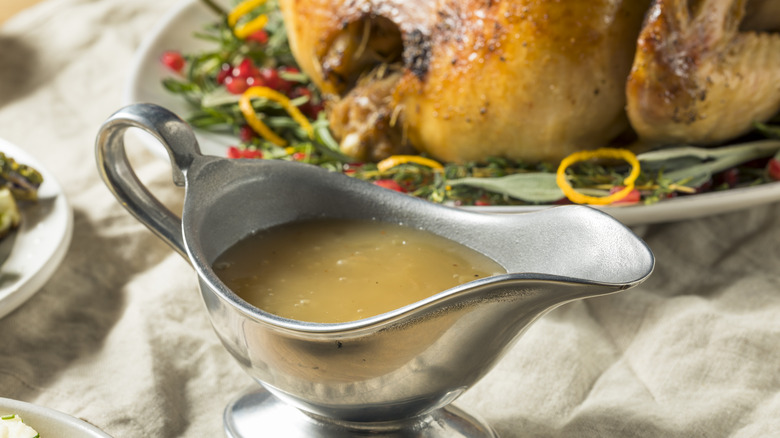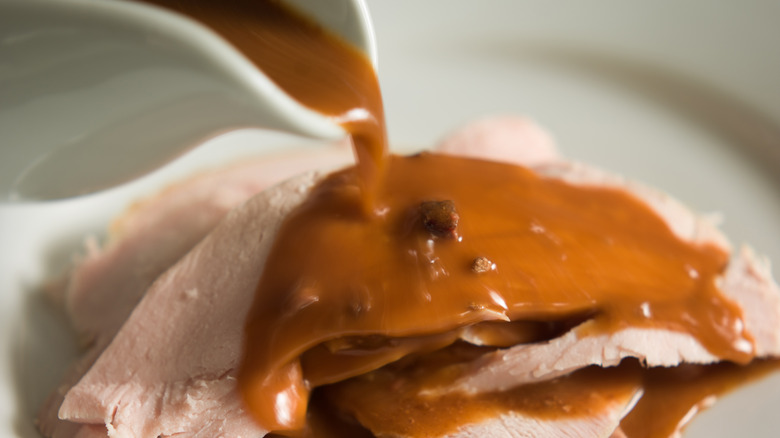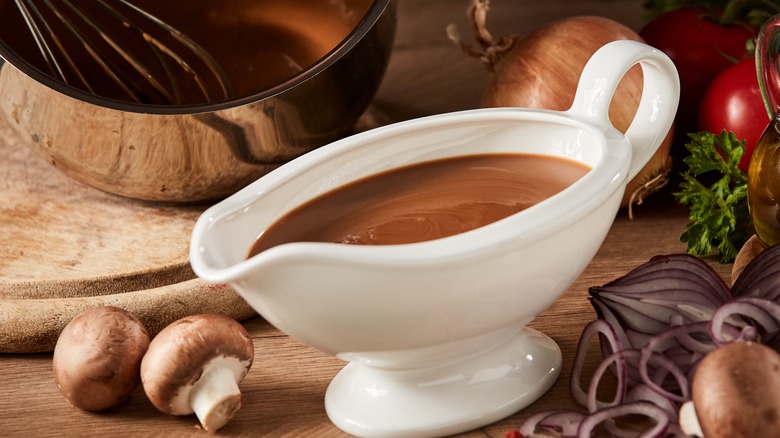Here's Why You Should Think Twice Before Freezing Gravy
While freezing food might be a method to avoid food waste, putting food on ice is not necessarily new. Although Clarence Birdseye might be credited with the modern frozen-food industry, one stumbling block had to be overcome for people to buy into the concept. It came down to taste — since some foods do not thaw with the same flavor and texture, not every item should be thrust into that icy compartment. One example is gravy.
When ice thaws into water, it looks like the liquid is in its original state. However, not all liquids hold the same properties. According to Palak Patel, a chef at the Institute of Culinary Education, dairy does not freeze well. Patel claims, "When you freeze things containing dairy, the fat will separate from the liquid forms in dairy. Separation—or, even worse, curdling—can occur because most common dairy items have been emulsified (via Martha Stewart).
Unlike trying to rectify a broken sauce, this separation causes issues in flavor and texture that are not easily fixed. If a sauce contains dairy, it might not be meant for the darkened corners of the freezer. Since some gravies can have milk, those gravies might be meant for one meal or maybe a day or two in the refrigerator. Unfortunately, it does not appear that Thanksgiving gravy should be frozen and then thawed for Christmas dinner.
Flour-based gravy can stand up to freezing
From the rich sausage gravy that smothers a plate of biscuits to the flavorful brown gravy made with the drippings from that Thanksgiving turkey, it can be hard to see any leftovers go down the drain. If you're tempted to freeze that gravy, there is one type that can taste just as good after being thawed.
While heavy-cream or dairy-based gravies should not be frozen, flour-based gravy can get the icy treatment. A flour-based gravy starts with a roux, equal parts flour and fat, along with a broth to create a liquid. While recipes vary, the basic premise is generally the same. Frozen flour-based gravy can be stored for up to three to four months.
Similar to other frozen foods, it is best to use care when thawing frozen gravy. Allowing the food to thaw in a refrigerator is preferred to let it sit on the counter or submerge it in hot water. Once thawed, the gravy may need additional liquid or thickener, like corn starch, as it simmers in a pan to return to its previous viscosity.
Freeze gravy in bags, containers, or ice cube trays
Digging into the freezer's depths might produce mystery food covered in icicles due to improper storage. Instead of guessing what mystery food should be thawed, thinking about how it should be frozen prior to getting cold should be a priority — that idea is a must with gravy.
The FDA sets out a variety of best practices when it comes to proper food storage, from freezer temperature to allowing the food to cool before hitting the icy domain. When it comes to a liquid like gravy, one idea is to freeze it in ice cube trays. Each cube can be easily defrosted for individual use, which avoids the problem that happened in the first place — too much gravy that went unused. You can also opt to use freezer bags or airtight containers to freeze your flour-based gravy.
If you decide to freeze your gravy, just be sure it's flour-based so you don't run into a lumpy, separated mixture. However, if it's not, it's probably best to make a new batch or run to the store for a packet.


